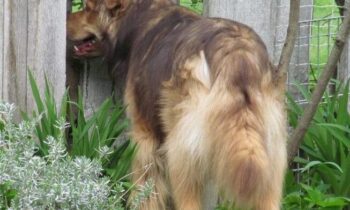

As I write this first paragraph of today’s blog, it’s been a little over a month since my dog was diagnosed with Canine Cognitive Dysfunction, or dog dementia. With the help of friends online, I’ve posted two articles addressed to novice dog guardians who may not be aware that such a condition exists, with personal stories and suggestions from dog lovers who’ve dealt with CCD.
I’d like to thank again all those friends and others who’ve contacted me with questions about my dog. How’s he doing? is usually asked first. Then, from those who’ve been in my shoes, How are you doing? often follows. In brief, I’ll say: With the help of our veterinarians and their staff, my dog and I are are both adjusting. We’re both sleeping better now, too, which to us is very important.

Photo by Val Hughes
Here are some of the questions that I have been asked:
How old is your dog?
He was picked up as a stray by animal control—no provenance. After I adopted him, his age was estimated by my veterinarian when I first took him in for a new-pet visit: approximately a year and a half. He’s lived with me for over a decade, so the best guess is that he’s now 11-plus years old.
What breed is your dog?
He’s a mutt! I’ve never had his DNA tested. He looks like an Australian Shepherd cross.
How has his health been generally?
Excellent. He had one back toenail amputated due to an injury, one tooth pulled and some other dental work—his teeth are not in great shape now. Otherwise, blood and urine tests show no major health issues going on at this time. He weighed 59 pounds at the time he was diagnosed with CCD. To quote his veterinarian, “He is not fat.” (I’ve been watching his weight for many years.)
What changes in his behavior had you noticed before the diagnosis?
I had noted several new-to-him behaviors, one that started late last winter—he had never been a snuggler, and he was choosing to lean up against me on the bed. I guessed that he had accidentally discovered the comfort of a wonderful heating pad that a dear friend had given me for Christmas. I used the pad often and, one day, he’d rolled over close enough to me that he was on the pad. It turns out that, even when the pad is not in use, he’s now choosing to lie close to me frequently.
Another new-to-him behavior that developed in the last six months was sensitivity to several common sounds around the house—the vacuum cleaner and the music of an app on my tablet. He’d never been bothered by the vacuum before, but he began choosing to leave the area when the vacuum was in use. He seemed okay with hanging out downstairs if I was vacuuming upstairs. Nothing had changed (nothing of which I am aware). The app was new—I’d just started using it on my tablet, on which he’s heard TV shows, movies, and games without reaction. His discomfort with this particular music was obvious: he fled the room. As with the vacuum, he chose to go away.
I chose to turn off the sound for that app completely. Why not?
Is there any change in his behavior that you noticed after the diagnosis?
Yes—an apparent loss of what had been excellent treat-taking skills. Always gentle: a tooth would never touch a human hand. I’d practiced treat-tossing with him so regularly that we’d developed a spot-on skill: when I “pitched” the treat in “our” style, he caught the treat every time, perfectly. Then, within days of his diagnosis, I “pitched,” he “caught”—and I felt the rush of air so close to my tossing hand, I heard the hard snap as his teeth slammed together. Oookay … I won’t be doing that anymore.
I now deliver his treats in an open palm, like feeding sugar to a horse.
I’ve heard a lot about loss of bite inhibition in dogs taking steroids. I asked around and yes, friends had seen a similar change in behavior in dogs taking anti-anxiety meds, like my dog. It’s a guess on my part, hardly scientific, but I “guess” that my dog might have lost his formerly great bite inhibition at this time, whatever the reason. I will act on that “guess” as a matter of safety. I will act with great care.
Also, I can no longer depend on my dog’s reliable recall. Luckily, he’s in a securely fenced yard where he has always been safe, as long as he’s lived here. But I no longer have the luxury of “expecting” him to be waiting on the back steps when it’s about time for him to come in, especially for a meal.
A month ago, when I understood that I should expect confusion and disorientation as a part of CCD, I realized that it was now up to me to be fully prepared to go to get him if he was clearly not going to come on his own. I say “prepared,” but I mean “ready”—dressed, safe shoes, long line, flashlight … and a big treat with which to “guide” him. After a month of going to get him when he does not come, I see that my dog is again running from the back fence to the house when I call him, most of the time.
It’s not what I had before, but it is getting better. I don’t know why.
His life may be feeling more familiar to him again. That might be part, I think, of our early “adjustments” to canine cognitive dysfunction. I know it could easily change again tomorrow, but I’m valuing every sign telling me he’s feeling more comfortable and safe, in the moment.
Thanks again to everyone who’s asked how we’re doing!



